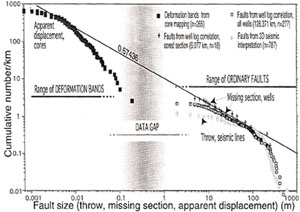| |||||||
|
|
|||||||
|
|
|||||||
| Scaling Properties of Faults | |||||||
|
Fault scaling relates fault size and frequency in one form or another. There are a lot data and theoretical arguments for a relationship between slip and fault length, fault rock thickness, and fault damage zone thickness (see the Table in Figure 1 from Scholz, 2002). Many of these studies conclude a fractal relationship of cL(n), 'n' being the power and 'c' is a constant. However, there is also substantial scatter in almost all the original data in log-log plot to make these relationships more complex and ambiguous.
One of the motivations to study fault scaling is to predict fault properties where data are not available (Yielding, 1996). In particular, it helps filling the gap among different data sets obtained by different methods as illustrated in Figure 2. As shown by the plot, core data is limited by the size of the cores, which is around 0.1 m in diameter and seismic and well log data have resolutions on the order of several meters. There is a large gap between these two data sets. Thus, scaling relationships can be utilized to populate subsurface rock volumes lacking data on fracture presence and attributes. | |||||||
| Types of Scaling Properties of Faults: | |||||||
| Scaling between Fault Rock Width and Fault SlipScaling between Fault Length and Fault Damage Zone WidthScaling between Fault Length and Maximum Splay LengthScaling between Fault Length and the Number of Segments per Unit LengthScaling between Fault Length and Fault Maximum SlipScaling between Fault Step Length and Step Width | |||||||
| Reference: |
|||||||
| Scholz, C.H., 2002 Yielding, G., Walsh, J.J., Watterson, J., 1992 Yielding, G., Needham, T., Jones, H., 1996 |
|||||||
|
Readme | About Us | Acknowledgement | How to Cite | Terms of Use | Ⓒ Rock Fracture Knowledgebase |
|||||||

